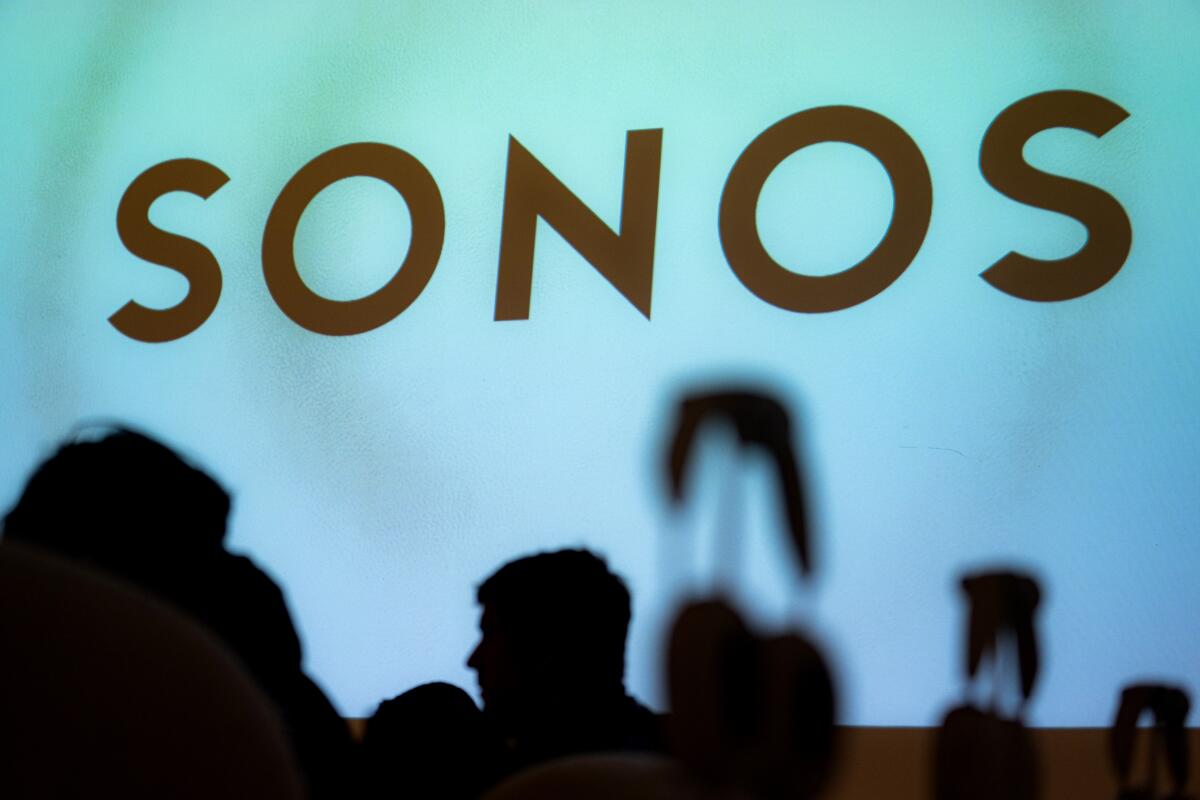Sonos tries to get its groove back after upsetting loyal customers

- Share via
Heath Evans really needed his Sonos speakers to work.
He and his wife counted on one of the three wireless devices he owned to play music to help put their baby daughter to sleep.
So, in May, when Sonos released a new controller app that was so riddled with problems he couldn’t get the speakers to work, Evans was angry.
“We just need reliable music that plays lullabies while we’ve got a screaming baby trying to go to sleep,” said Evans, a 40-year-old entrepreneur in Australia who had received the speakers from his wife last year for his birthday.
Fed up with the time Sonos has taken to fully fix the app, the family has given up on trying to use the devices, which cost about $1,300. They’ve turned instead to a cheap speaker to stream music for their daughter’s bedtime.
Evans is among a legion of unhappy customers who are upset with Santa Barbara-based Sonos. Today, the company is still trying to mitigate the fallout from the app debacle and salvage its reputation as a powerhouse in the audio industry offering an array of portable, high-quality wireless speakers. The hit to Sonos’ brand has swung the door open for rivals such as Amazon, Bose, Apple and other tech giants that make smart speakers to capture more of the business’ customers.
“Sonos knows it is on precarious ground because while it has built up customer goodwill, it plays in a highly competitive space,” said Dipanjan Chatterjee, vice president and principal analyst at research firm Forrester in an email.
Over its more than 20 years, the publicly traded company has weathered tough times before, including the 2008 financial crisis. But its latest misstep is a multimillion-dollar blunder that has forced it to delay the launch of new products and lower sales projections for the pivotal final months of the year when they otherwise would be looking to capitalize on a holiday sales boost.
Sonos said it’s spending $20 million to $30 million to fix the app and provide more customer support — an emergency investment it hopes will win back the trust of customers and steady its financial footing. In the last six months, the company’s stock, which ended trading Thursday at $11.58, has fallen 39%. In the quarter ending June 29, it reported $397 million in revenue, a 6% increase over the same period last year, and $3.7 million in net income.
This week, the company outlined a plan to make sure it doesn’t have similar failures in the future, including improvements to how it tests products before they’re released, the appointment of a “quality ombudsperson,” creation of a customer advisory board, and extending its warranty for certain items, such as its home theater and plug-in speaker products. Executives agreed to forgo their annual bonuses for 2025 unless their turnaround plan succeeds.
“There are many wonderful brands that have made missteps, have gone out and apologized to fix things and won back the trust of their customers,” said Eddie Lazarus, Sonos’ chief strategy officer. “We’re going to be the next one in that line.”
Sonos was founded in 2002 by a group of entrepreneurs who set out to build something that is commonplace today but pioneering at the time: a wireless audio system that would enable people to play music over the internet anywhere in their home. They were working years before the start of popular streaming services such as Spotify and Pandora, as well as the launch of the iPhone.
In January 2005, the company released the ZP100, a device with a remote control that allowed people to stream music through their computers. The product garnered positive reviews including from Walt Mossberg, a tech columnist at the Wall Street Journal, who called the Sonos music streaming system “easily the best music-streaming product I have seen and tested.”
As in many startups, Sonos executives were worried about competitors . The first song played publicly on the ZP100 was the Beastie Boys’ “No Sleep Till Brooklyn,” a tune engineers could relate to as they hustled to improve the quality of the device before its release.
Appearing on the podcast “How I Built This with Guy Raz” this year, one of the founders, John MacFarlane, recalled the pressure he and others felt to unveil their first product in time for the holiday season — a goal they ultimately missed. Releasing the ZP100 before it was ready would have “killed the company,” he said.
“You had to have a great positive first experience if you’re going to build the brand on word of mouth,” MacFarlane said.
The challenge of striking a balance between moving fast and having a good product is still a challenge that Sonos and other tech companies have grappled with throughout their history. Apple faced backlash from its customers in 2012 when it released a Maps app that contained inaccurate driving directions, Chatterjee said. But Sonos is in a “trickier” spot because the app is part of what makes the company’s audio system function seamlessly for the 15 million households that use its products globally.
“Without that seamlessness, there is no ease of use, and without the ease of use, the company cannot command its premium price with consumers or its premium position in the market,” he said.
Sonos Chief Executive Patrick Spence has acknowledged that the company has let down its customers. He told investors in August after Sonos released its quarterly earnings that the company had to rebuild the app to address “performance and reliability issues” and position the company for growth as the company expands “into new categories and move ambitiously outside of the home.” Sonos released its first pair of headphones in June.
For some Sonos customers like Evans, Sonos’ response has been “tone deaf,” underscoring the trust the company still needs to win back.
“Why on earth would I care about a quality ombudsman? I’m a guy sitting in Melbourne nursing a baby in Australia with a speaker that doesn’t work,” he said.
Despite looking at the possibility of bringing back the previous version of the Sonos app, Lazarus said the company ruled it out because there were a lot of “technical concerns.” While the company has said it’s reintroduced many of the features from the old version of the app that were missing in the new one, he acknowledged the company still has work to do. He couldn’t say when the app will be completely fixed.
Other customers have found workarounds to still stream their music from their Sonos speakers even if the app doesn’t work.
Fearing issues with the rollout of the new app, 32-year-old product designer Matthew Mocniak said, he disabled his Sonos system from automatically updating the app but the solution worked only temporarily.
Mocniak, who lives in North Carolina and has spent more than $2,000 on Sonos speakers, said he’s able to stream music through Apple’s Airplay feature.
As someone who works in the tech industry, Mocniak knows rebuilding software can be harder than it looks. “It’s very easy to promise certain features or certain deadlines,” he said. “It’s also easy to forget that there are people responsible for that stuff on the other side.”
Ben Brown, a 49-year-old creative director in the United Kingdom, said his Sonos app still says his speakers are not connected. Instead, he’s been using Amazon’s Alexa assistant to play music on the speakers.
Brown, who also purchased multiple Sonos speakers for his home, said he was so frustrated that he felt the urge to throw the Sonos Roam portable speaker in the sea while on vacation.
“I would never have done it, really, but that’s how angry it makes you,” he said. “It’s those moments where you just want to take a speaker outside, eat some dinner and listen to some music.”
More to Read
Inside the business of entertainment
The Wide Shot brings you news, analysis and insights on everything from streaming wars to production — and what it all means for the future.
You may occasionally receive promotional content from the Los Angeles Times.











